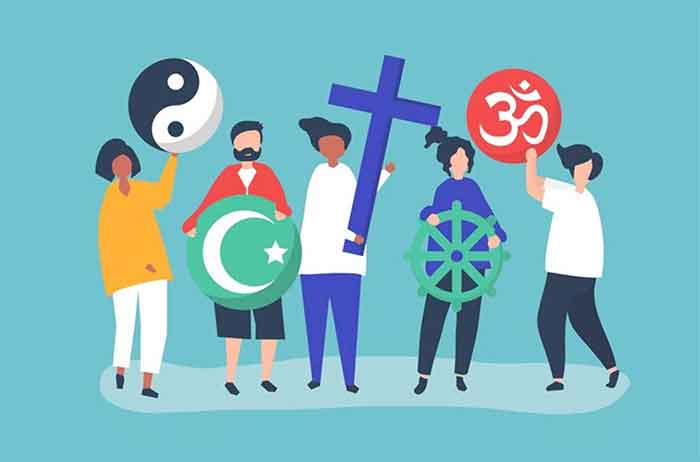
It is an undeniable fact of Indian history that all those leaders of the freedom movement who received the greatest support and affection of people were those who had very firm faith in communal harmony. For Jawaharlal Nehru inter-faith harmony was a matter of the deepest commitment and a firm base for the progress of the country. Badshah Khan could show with his inspiring achievements how communal harmony could be achieved even in the most adverse conditions. Subhash Chandra Bose made communal harmony an important principle on the basis of which to inspire a united struggle against colonial rule in very difficult conditions. Mahatma Gandhi and Shahid Bhagat Singh, two of the greatest freedom fighters of India, may have walked different paths but they were united in several ideals and in particular they were one in emphasizing the great importance of inter-faith unity and harmony in India.
In fact it is when such great leaders committed to inter-faith harmony were imprisoned (as during the 1942 upsurge) and hence unable to reach their people that the colonial regime could get the most opportunity for assisting the divisive forces and their leaders to expand and spread their web of sectarianism and division of people.
The great unity shown by people of various religions during the 1857 uprising had alarmed the colonial forces who pursued a divisive agenda in well-planned ways after this. While pursuing this, they encouraged the birth and spread of several communal and divisive organizations and these sectarian organizations in turn helped the colonial regime in various ways. Many freedom fighters recognized the great danger of this and made inter-faith harmony an essential part of their agenda of mobilizing people for the freedom of the country and for creating a country based on equality and unity after this. They achieved much success but the colonial forces were more powerful and particularly during the frequent times when the freedom fighters were imprisoned on a mass scale, they got more opportunities to push their divisive agenda, thereby creating the ground for the partition of the country.
As communal forces have posed increasing threat to national unity in recent decades in India, it has become increasingly important to highlight the strength and resilience of the country to resist and defeat such assaults on social harmony and secular constitution of the nation. It is even more important now than before to highlight the heritage of mutual respect, co-operation and assimilation among people of various faiths and communities in our country. This heritage in fact goes back to very early days.
In the initial phase of interactions between Hindus and Muslims, several visiting Muslim scholars came to India with a very open mind with a spirit of learning. They carried back from India several works of wisdom and these were then translated into Arabic. Acknowledging this intellectual gift, Arab author Yaquibi wrote in the year 895, “The Hindus are superior to all other nations in intelligence and thoughtfulness. They are more exact in astronomy and astrology than any other people. The Brahma Sidhanta is a good proof of their intellectual powers, by this book the Greeks and the Persians have also profited.” Another Arab historian Qazi Said wrote, “The Hindus have always been considered by all other people as the custodians of learning and wisdom.”
Thus the very first contacts were favourable, and these were strengthened subsequently at the upper level by certain liberal policies initiated by Akbar and and several other Muslim rulers. More important, at the grassroots level, these ties were strengthened by the Bhakri and Sufi movements which emphasized the unity of God and religions and attracted millions of followers.
Akbar respected and listened to the views of learned men from several religions including not only Hindus and Muslims but also Sikhs, Christians and others. He gave liberal grants for maintenance of Hindu temples. He started a translation department to get the Ramayana, the Mahabharata and the Bible translated into Persian language.
In the Deccan kingdoms, a sixteenth century king Adil Shah followed a similar path. He established a very good library to look after which he appointed a Sanskrit scholar Vaman Pandit. His descendent Ibrahim Adil Shah was called the ‘friend of the poor’ and ‘world’s teacher’ due to his policies of benevolence and goodwill. In his songs he often pays respects to Saraswati, the Hindu Goddess of learning. He played an important role in the development of some Hindu religious places.
In Kashmir the 15th century king Zain-ul-Abdin was a scholar of Sanskrit as well as Persian, and played an important role in translating parts of the Upanishads into Persian. He publicly participated in Hindu festivals and constructed temples. In Bengal Pathan kings like Sultan Nazir Shah and Sultan Hussain Shah followed similar policies and arranged for the translation of Mahabharata and Bhagwat Puran into Bengali.
A governor of the Vijaynagar empire at Mangalore committed some excesses and damaged four mosques. When this was made known to a higher officer called Baicheya Dannayaka and Emperor Devaraya II of the Vijaynagar empire, they ordered payment of compensation to the Muslims for repair of the four mosques.
King Jayasimha of the Solanki dynasty who ruled Gujarat in the first half of the 12th century was known for his sense of justice. When he came to know of the destruction of a mosque in Cambay then, having confirmed the news properly, he punished the culprits and gave 2,00,000 silver coins to the Muslims of Cambay to rebuild the mosque.
The Portuguese visitor Barbosa who visited the Vijaynagar empire between 1512-14 said, “The King allows such freedom that every man may come and go and live according to his own creed without suffering any annoyance and without any enquiry, whether he is Christian, Jew, Moor or Heathen.”
Bahmani Sultan Alla-ud-Din II (1436-58) was devoted to Narasimha Saraswati, a great Hindu sage. Ibrahim II, the Adilshahi ruler of Bijapur was also a devotee of Narasimha Saraswati. He built a small shrine near his palace in Bijapur and placed the paduka (footwear) of the saint here.
But more important was the impact of the Bhakti and Sufi movements at the grassroots level. These poets and teachers spoke against the artificial and ritualistic divisions among religions and in favour of the essential unity of all religions. They emphasized basically the purity and depth of the relationship between God and the devotees. The strength of this relationship would render the various rituals and artificial impositions as insignificant. They wrote devotional songs and poems in the common man’s language, thereby eliminating the necessity of intermediaries in worship.
Thus despite several adverse factors and problems, a certain integration and assimilation of Hindu and Muslim population was certainly taking place before the advent of the British rule.
Despite British efforts to divide and rule, the impact of this integration could be seen in the 1857 uprising against British rule in which Hindus united with the Muslims in an effort to oust the foreign rulers. This prompted the colonial rulers to initiate even more organized efforts to promote communal divides, but despite this great examples of communal harmony could be seen time and again in the glorious Gandhian path of the freedom movement, in the struggles led by Subhash Chandra Bose and in the struggles led by revolutionaries like Shahid Bhagat Singh. It is this heritage of mutual respect, cooperation and assimilation which has faced increasing threat in recent times and so needs special efforts today for its protection and promotion.
Bharat Dogra is Honorary Convener, Campaign to Protect Earth Now. His recent books include When the Two Streams Met (Freedom Movement of India ) and Man Over Machine (Gandhian Ideas for Our Times).













































